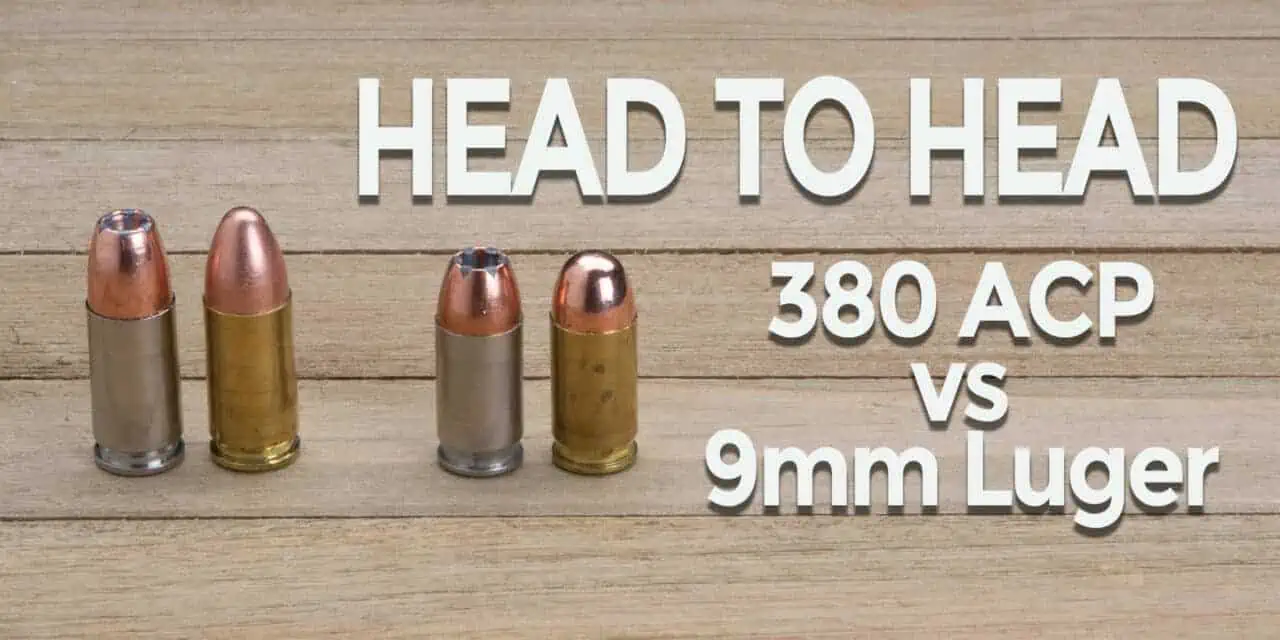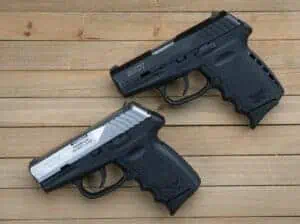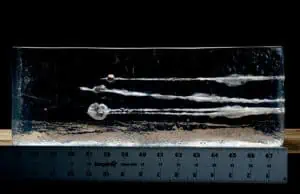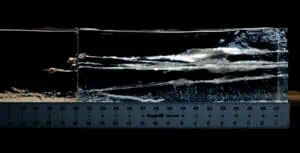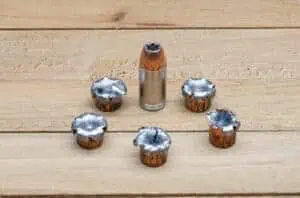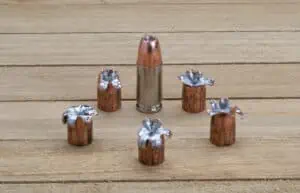Let’s Look At 380 ACP vs 9mm Luger
The 9mm Luger round is one of the most popular centerfire pistol cartridges in America today. It is smaller than its two closest competitors, .40 S&W and .45 ACP, which allows for more rounds to be carried in similarly-sized magazines. However, despite its smaller size, modern bullet design has turned 9mm into an effective and reliable defensive pistol round.
In recent years, though, there has been a resurgence of interest in 9mm’s smaller cousin, the .380 ACP cartridge. Thanks to pocket pistols like the Ruger LCP and a host of larger-sized guns, the .380 ACP round is gaining new life as a defensive pistol cartridge. Let’s look at some of the things that separate .380 vs. 9mm.
Two Different Roads, Similar Destinations
First, a brief history of the two cartridges. Despite their similar sizes (9x17mm for .380 ACP and 9×19 for 9mm Luger), the two rounds do not share a common heritage. John Moses Browning designed .380 ACP as a variant of his 38 ACP round. The .380 ACP round (also known as 9mm Short or 9mm Kurz) quickly gained popularity, especially in Europe. Service pistols chambered in .380 ACP, such as the Beretta M1934 and Browning Model 1922 serving well into World War II.
The 9mm Luger round was designed by (you guessed it) George Luger. Luger expanded the neck of the pre-existing 7.65 Luger round to take a 9mm diameter bullet, and the rest is history. 9mm slowly gained acceptance, first as a round for submachine guns, then as a service pistol cartridge. John Moses Browning and Dieudonné Saive took the 9mm cartridge, squeezed 13 rounds into the magazine of the pistol. Having done such, the modern high-capacity 9mm defensive pistol we know today was born.
Testing 380 vs 9mm
Now let’s get to our tests. We’ll need to level the playing field as much as possible to get a better understanding of the differences with 380 vs 9mm. This can be difficult, as .380 pistols tend to be chambered in smaller guns compared to 9mm. Fortunately for our purposes, Sccy Firearms makes two very similar pistols. One is chambered in 9mm and the other in .380 ACP, that are almost identical in size and features.
The 9mm Sccy CPX-2 is a hammer-fired, double-action only (DAO) pistol that weighs 15 ounces and has a barrel just over 3 inches long. The Sccy CPX-3, however, shoots .380 ACP and also weighs 15 ounces, with a barrel that is just under 3 inches long. All the other features on these two guns (sights, trigger pull, etc.) are identical. This allows us to compare the cartridges they fire, not the guns themselves.
First, we’ll do a quick comparison of what a round of 380 ACP brings to the table versus 9mm Luger. We shot 10 rounds of three different .380 ACP rounds, and 10 rounds of three 9mm rounds from the same manufacturer. We measured their velocity as they left the barrel of each gun with a chronograph. This will give us a better understanding as to how much power is in 380 vs 9mm.
380 Ammo Tested:
| Blazer Brass 95 Gr FMJ Average Velocity: 901 fps Average Muzzle Energy: 171 ft/lbs | PMC 90 Gr FMJ Average Velocity: 918 fps Average Muzzle Energy: 168 ft/lbs | Speer GoldDot 90 Gr JHP Average Velocity: 952 fps Average Muzzle Energy: 181 ft/lbs |
9mm Ammo Tested:
| Blazer Brass 115 Gr FMJ Average Velocity: 1053 fps Average Muzzle Energy: 283 ft/lbs | PMC 115 Gr FMJ Average Velocity: 1094 fps Average Muzzle Energy: 306 ft/lbs | GoldDot 124 Gr JHP Average Velocity: 1070 fps Average Muzzle Energy: 315 ft/lbs |
The lower velocity and lighter bullet inside a round of 380 ACP means that it has less muzzle energy when it leaves the barrel compared to a round of 9mm. This impacts its usefulness as a defensive cartridge in two different ways. On the downside, that lower amount of energy means less penetration into the target. This, in turn, means a lower chance of stopping a threat with any given shot. On the plus side, lower muzzle energy means lower recoil. This means that follow-up shots will be faster if they are needed.
To test the effect of the lower muzzle energy of 380 vs 9mm on the target, we’ll shoot five rounds of 380 and 9mm Gold Dot jacketed hollowpoint (JHP) ammunition into a block of Clear Ballistics gel. The shots will be covered with the same layers of cloth used in FBI ballistics testing, and the blocks will be positioned 10 feet away from each pistol. Ideally, the rounds we shoot should expand upon impact and penetrate anywhere between 12 and 16 inches into the gel.
Penetration Testing Results
380 ACP Speer Gold Dot JHP (Average of 5 Rounds)
Minimum Penetration Depth: 10.75 inches
Maximum Penetration Depth: 11.75 inches
Average Penetration Depth: 11.22 inches
Average Bullet Width: 0.47 inches (+0.12 inches expansion)
9mm Speer Gold Dot JHP (Average of 5 Rounds)
Minimum Penetration Depth: 16 inches
Maximum Penetration Depth: 16.75 inches
Average Penetration Depth: 16.4 inches
Average Bullet Width: 0.51 inches (+0.14 inches expansion)
I was pleasantly surprised by the .380 ACP results. I was expecting the Gold Dot JHP rounds to penetrate 10 inches or less. The fact that they all expanded and came close to the FBI minimum penetration standard gives me confidence in their ability to stop a threat on-demand.
The 9mm Gold Dots, on the other hand, overachieved on the penetration and didn’t expand as much as I was expecting. Are they a poor choice for a 9mm defensive round? No, of course not. However, I do think there are better options available in 9mm right now, and it might be worth your time to research them out.
380 vs 9mm Recoil Test
To see what effects the lower muzzle energy of 380 vs 9mm might have on recoil, we’ll shoot three Bill Drills each with both calibers and take the average time for each caliber. We’ll shoot the drill from a distance of 8 yards and use a steel target the same size as a USPSA A-Zone target in order to give us better confirmation of our hits. As the guns we’ll be shooting are essentially identical to each other, except for caliber, lower average time will be the result of the rounds fired, not the gun.
Test Results
9mm Sccy CPX-2 Average Bill Drill Time: 5.12 Seconds
380 Sccy CPX-3 Average Bill Drill Time: 4.14 Seconds
Based on these results, your shots will speed up by around 0.2 seconds using 380 vs 9mm. That’s actually quite a lot. I know many competition shooters who would love to decrease their time in-between shots by 0.2 seconds, and switching to 380 ACP seems to make that happen.
That lower time tells only half the story, though. Not only was the .380 version of the Sccy faster in between shots, it was also easier to control under recoil. I was easily able to get all five shots onto the A Zone target with the .380 Sccy CPX-3. With the 9mm version, getting all five hits onto the steel was a challenge. I had to make multiple runs in order to get three examples to compare against the .380 Sccy.
Not The Handicap I Thought It Was
I’ve carried a 380 pocket pistol for over a dozen years now, I’ve trained with them, I’ve practiced with them, I’ve shot various drills with them and I know what I can and can’t do with a gun of that size and of that caliber. These tests have made me realize that while there may still be some disadvantages of going with a gun chambered in 380 vs 9mm, those disadvantages are not as big as I thought they were. Yes, there is some difference between the two cartridges, especially when it comes to penetration in a target. However, those differences are not as big as you might think. 9mm is still my preferred cartridge for concealed carry, but now I have more confidence in my ability to defend myself with my little 380 pocket gun, which is a very good thing indeed.

